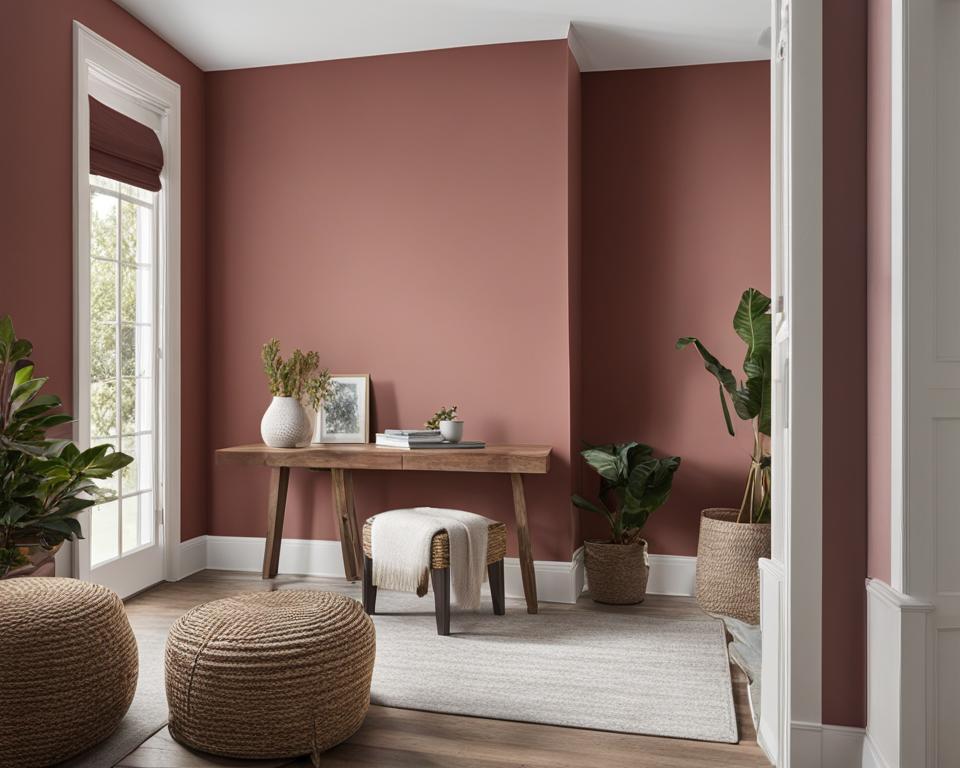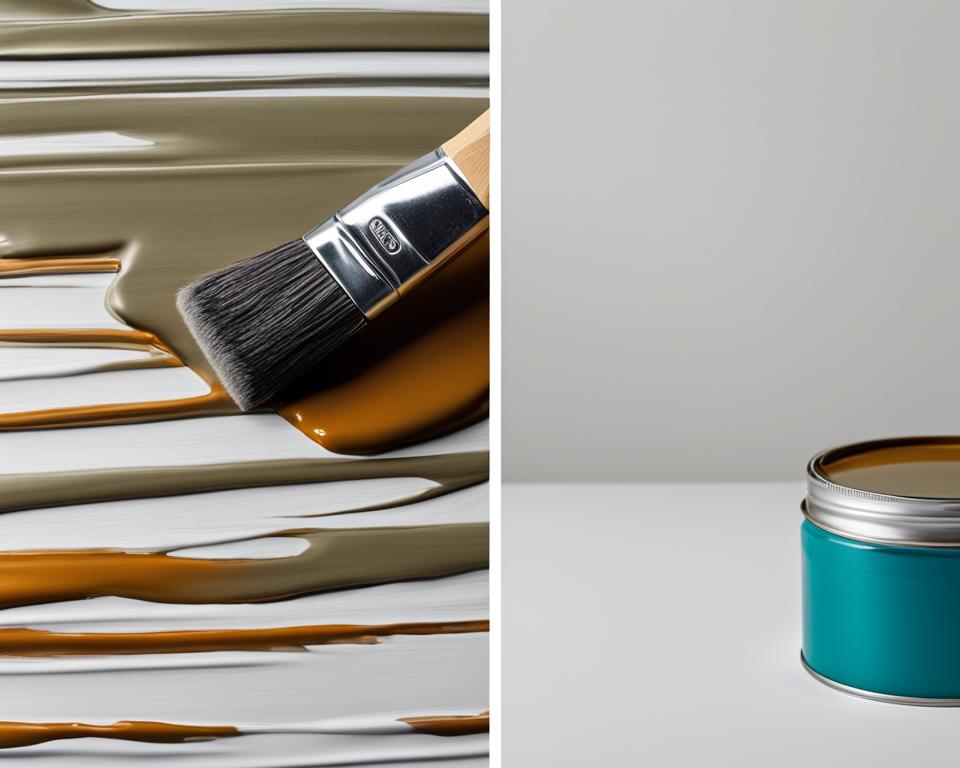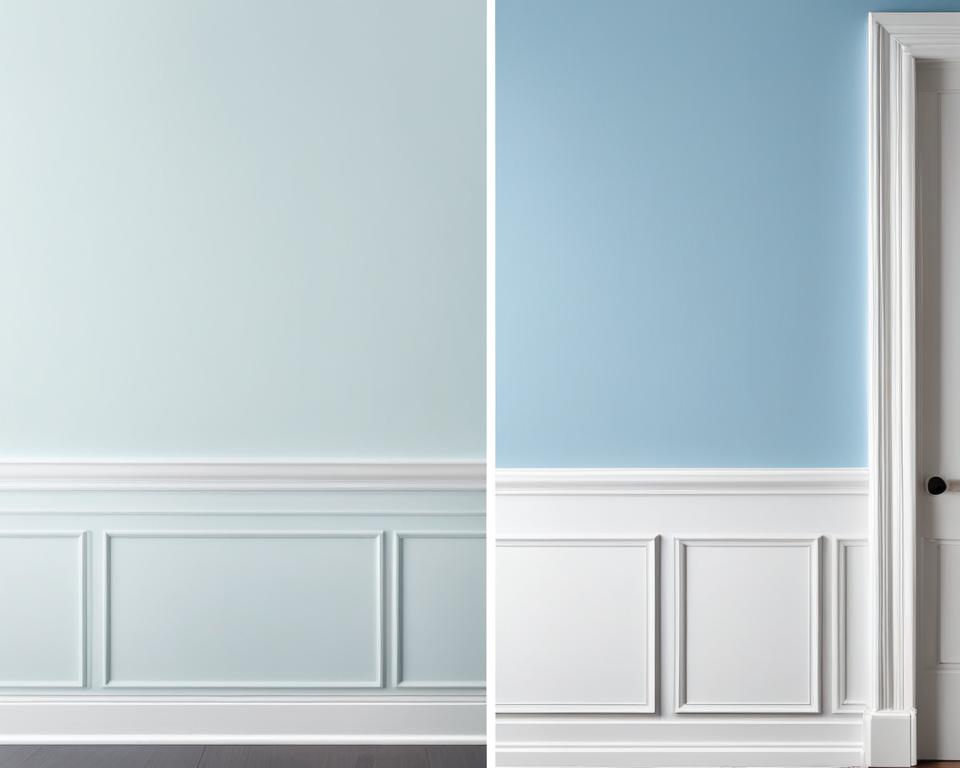When it comes to painting your home, choosing the right paint for your trim and walls can make a significant impact on the overall look and feel of the space. While both trim paint and wall paint serve a similar purpose, there are key differences that you need to know. Let’s explore the difference between trim paint and wall paint and how to choose the right paint for your trim and walls.
One of the easiest ways to make a room feel larger and richer is to paint walls and trim the same color. Painting walls and trim the same color has become a popular design trend due to its many advantages. It creates a cohesive and unified look, making the space feel more open and seamless. When painting walls and trim the same color, it is recommended to use a semi-gloss finish for the trim and an eggshell finish for the walls. This combination provides durability for the trim and a slightly lower sheen for the walls. Painting trim and walls the same color can hide unwanted elements in the room and elevate the overall space. It can also create an understated elegance and make ceilings appear higher. This design trend is versatile and can be applied to various home styles. Whether you choose to paint trim the same color as the walls or opt for contrasting colors, it is important to carefully consider the sheen, finish, and overall aesthetic of the space.
Key Takeaways:
- Painting walls and trim the same color creates a cohesive and unified look, making the space feel more open and seamless.
- When painting walls and trim the same color, use a semi-gloss finish for the trim and an eggshell finish for the walls.
- Painting trim and walls the same color can hide unwanted elements in the room and make ceilings appear higher.
- Consider the sheen, finish, and overall aesthetic of the space when choosing whether to paint trim the same color as the walls or opt for contrasting colors.
- Remember to use high-quality paint brands like Behr, Benjamin Moore, Sherwin-Williams, and Valspar for the best results.
Now that you understand the key differences between trim paint and wall paint, as well as how to choose the right paint for your trim and walls, you can confidently embark on your painting project. Whether you decide to create a cohesive look or go for a contrasting color scheme, remember to consider the sheen, finish, and overall aesthetic of your space to achieve the desired results.
Benefits of Using Trim Paint
When it comes to interior design, using trim paint offers numerous benefits that can enhance the overall look and feel of a room. By expertly blending the trim with the walls, trim paint helps create a cohesive and unified look. This seamless integration can make the space feel more open and visually appealing.
One of the advantages of using trim paint is its ability to add a decorative touch to the room. It highlights architectural elements like crown molding and baseboards, adding an elegant and sophisticated aesthetic. Trim paint not only enhances the overall design, but it also protects the lower portion of the wall from scrapes and scratches, ensuring long-lasting beauty.
Another benefit of using trim paint is its ability to elevate the overall space. By carefully selecting the color and finish of the paint, trim can help make ceilings appear taller, creating a sense of grandeur in the room. Whether you choose a classic white or a bold color, trim paint has the power to transform the look and feel of any space.
On the other hand, wall paint provides a decorative finish for the walls themselves. It offers a wide range of color options and finishes, allowing you to choose the perfect combination to achieve your desired aesthetic. Whether you prefer a matte, satin, or glossy finish, wall paint can help bring your vision to life.
Ultimately, the use of trim paint and wall paint comes down to personal preference and the desired design outcome. While trim paint offers benefits such as a cohesive look, decorative touch, and protection, wall paint allows for customization and the opportunity to express your unique style.
“Using trim paint can transform the look and feel of any space, adding elegance, protection, and a sense of unity.” – Design Expert
Table: Comparison of Trim Paint and Wall Paint
| Benefits | Trim Paint | Wall Paint |
|---|---|---|
| Creates a cohesive look | ✔ | ✖ |
| Highlights architectural elements | ✔ | ✖ |
| Protects lower portion of the wall | ✔ | ✖ |
| Elevates the space | ✔ | ✖ |
| Offers customization options | ✖ | ✔ |
Choosing the Right Paint for Trim and Walls
When it comes to selecting the perfect paint for both trim and walls, there are several important factors to consider. Making the right choice can ensure a harmonious and visually appealing result for your space. In this section, we will explore the key considerations for choosing between trim paint and wall paint, including the type of paint, sheen level, color, and finish.
Type of Paint
First and foremost, it’s essential to choose the appropriate type of paint for your project. Exterior paint is specifically designed to withstand harsh weather conditions and provide long-lasting durability. On the other hand, interior paint focuses on aesthetics and comes in a wide range of colors and finishes.

Sheen Level
When it comes to trim paint, the sheen level plays a vital role in determining the final look and durability. Trim paint is typically available in satin, semi-gloss, gloss, or high-gloss finishes. Each sheen level offers different characteristics, ranging from a subtle sheen to a brilliant shine. Consider your personal preference and the desired level of durability and shine when selecting the sheen level for your trim paint.
Color and Finish
“Color is a power that directly influences the soul.” – Wassily Kandinsky
The color and finish of your paint can greatly influence the overall aesthetic of your space. White trim has long been a popular choice for creating a classic and timeless look. It adds a touch of elegance and pairs well with various wall colors. However, don’t be afraid to venture beyond white and explore different colors to add a pop of character or create a striking contrast. Consider the overall style and ambiance of the room to ensure that the trim and wall colors and finishes complement each other harmoniously.
Choosing Between Trim Paint and Wall Paint
Deciding between trim paint and wall paint ultimately depends on your personal preference and the desired design outcome. Painting trim and walls the same color can create a cohesive and unified look, making the space feel more open and seamless. Conversely, contrasting trim can add visual interest and break up the space. Take the time to envision the end result and consider how trim paint or wall paint can enhance the overall aesthetic of the room.
Remember: Always consider the compatibility of the colors and finishes when selecting paint for both trim and walls.
| Factors | Trim Paint | Wall Paint |
|---|---|---|
| Type of Paint | Specifically formulated for trim | Available in various colors and finishes |
| Sheen Level | Satin, semi-gloss, gloss, or high gloss | Various finishes, including matte, eggshell, satin, or semi-gloss |
| Color and Finish | White or other colors for a classic or dramatic effect | Wide range of colors to suit the desired aesthetic |
Choosing the right paint for both trim and walls is a crucial decision in achieving a cohesive and visually pleasing interior. By carefully considering the type of paint, sheen level, color, and finish, you can create a space that reflects your personal style and enhances the overall ambiance.
Tips for Painting Trim and Walls
Painting trim and walls requires careful preparation and execution to achieve the desired results. Here are some tips to help you select the right paint and achieve a professional finish:
1. Prepare the Surface
Before painting, make sure to sand any rough spots and fill in any holes or cracks in the trim and walls. This will ensure a smooth and even application of paint.
2. Use a Stain-Sealing Primer
If you’ve sanded or filled any areas, or if there are bare wood or stains, it’s important to apply a stain-sealing primer. This will prevent bleeding through and ensure a uniform finish.
3. Apply Painter’s Tape
To protect the edges of the walls and floors, apply painter’s tape before painting. This will create clean and sharp lines, giving your trim and walls a professional look.
4. Use the Right Tools
When painting trim, it’s recommended to use a 2-inch trim brush with a slanted edge. This will make application easier and help you achieve a smooth finish.
5. Paint in Quick Movements
Start painting around 1/4 inch away from the edge of the trim and gradually move closer to create a smooth, even coat. Use quick movements for a consistent application.
6. Let the Paint Dry Before Removing Tape
It’s important to let the paint dry until it’s tacky before removing the painter’s tape. This will prevent any fresh paint from lifting along with the tape, ensuring clean lines.
7. Choose High-Quality Paint
When selecting paint for trim and walls, opt for reputable brands that offer high-quality products. Brands like Behr, Benjamin Moore, Sherwin-Williams, and Valspar are known for their durability and range of colors.

By following these tips and using the right techniques, you can achieve professional-looking results and enhance the overall aesthetic of your space.
Conclusion
When considering the best paint for trim and walls, it’s crucial to evaluate the overall aesthetic of the room, the desired durability and sheen level, and the compatibility of colors and finishes. While painting trim and walls the same color can create a cohesive and seamless look, opting for contrasting trim can also add visual interest and enhance the space. Ultimately, the decision between trim paint and wall paint boils down to personal preference and the desired design outcome.
To achieve professional-looking results, it’s important to follow proper preparation and painting techniques. This includes sanding rough spots, filling in holes and cracks, and applying a stain-sealing primer before painting. Using quality paint from reputable brands, such as Behr, Benjamin Moore, Sherwin-Williams, and Valspar, ensures a high-quality finish. Additionally, choosing the appropriate tools, such as a 2-inch trim brush with a slanted edge for easy application, can make a significant difference in the final result.
By carefully considering the factors mentioned above and taking the necessary steps to prepare and paint effectively, homeowners can transform their spaces and elevate the overall aesthetic of their homes. Whether opting for trim paint or wall paint, it’s essential to prioritize the durability, sheen, and compatibility of colors and finishes to achieve the desired look.
FAQ
What is the difference between trim paint and wall paint?
Trim paint is specifically formulated for use on trim, such as baseboards and crown molding, while wall paint is designed for painting the walls of a room. Trim paint often has a higher sheen and provides additional durability, while wall paint comes in a variety of finishes and colors to suit different aesthetic preferences.
How do I decide between trim paint and wall paint?
The decision between trim paint and wall paint depends on personal preference and the desired design outcome. If you want a cohesive look, painting the trim and walls the same color can create a seamless and open feel. However, contrasting trim can add visual interest and break up the space. Consider the overall aesthetic of the room and the compatibility of colors and finishes when making your decision.
What are the benefits of using trim paint?
Trim paint offers several benefits in interior design. It creates a cohesive and unified look by blending the trim with the walls, making the space feel more open. Trim paint also highlights architectural elements, adds a decorative touch to the room, and can make ceilings appear taller. Additionally, it protects the lower portion of the wall from scrapes and scratches.
How do I choose the right paint for trim and walls?
When selecting paint for trim and walls, consider the type of paint (interior or exterior), the desired sheen level (satin, semi-gloss, gloss, or high gloss), and the color and finish that will complement the overall aesthetic of the room. It is important to choose high-quality paint from reputable brands to achieve professional-looking results.
What are some tips for painting trim and walls?
Before painting, prepare the surfaces by sanding rough spots and filling in holes or cracks. Apply a stain-sealing primer to sanded or filled areas, as well as bare wood or stains. Use painters tape to protect edges, and select the appropriate brush for trim painting. Apply the paint in smooth, even coats, letting it dry until tacky before removing the tape.
